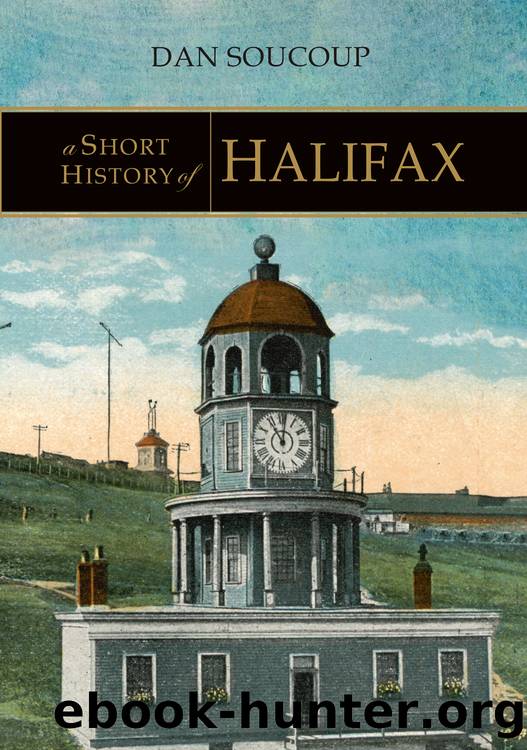A Short History of Halifax by Dan Soucoup

Author:Dan Soucoup
Language: eng
Format: epub
Publisher: Nimbus Publishing
Published: 2014-06-03T17:04:01+00:00
Academy of Music, Barrington Street, c.1908. The academy opened in 1877 and was one of the first public buildings in the city to be lighted by electricity.
âCourtesy Dan Soucoup
The 1880s became a significant decade for the cityâs arts community. In addition to the art school, Zwickerâs Gallery, Canadaâs oldest commercial art gallery, was established in the North End by Judson A. Zwicker. The Academy of Music had opened on Barrington Street and would be the cityâs major theatre and music centre with its own repertory company until it was torn down in 1929 to make way for a motion picture theatre.
The city had already opened a free library and continued to expand its horizons. The decade was also significant for the advancement of womenâs rights, as Margaret Florence Newcombe became the first woman to graduate from Dalhousie University, with a BA in 1885, and Maria Angwin became the first woman to be licensed to practice medicine in the province.
In 1890 a new city hall opened on the Grand Parade. Six years later an electric trolley service offered citizens transportation up and down Spring Garden Road and Barrington Street, as well as out to Willow Park. Electric street lights were installed and the upper streets below the Citadel were slowly being cleaned up as the brothels and drinking dens were torn down to make way for three-storey brick structures. The new Victorian morality and the politically powerful temperance societies were demanding change: old Barrack Street was renamed Brunswick while fine new homes were erected on the street north of the hill.
As the Dartmouth side of the harbour began to expand, the need to secure rail connections became apparent. In 1885 the Intercolonial Railway built a steel-swing railway bridge across the harbour at The Narrows, but it was destroyed by a storm. A second harbour bridge was erected, although it, too, collapsed, making it necessary to build a spur rail line from Windsor Junction into Dartmouth. Almost sixty years would pass before another bridge would finally span the harbour.
The first Jewish synagogue was opened on Starr Street in 1894, and immigration to Canada began to accelerate again in the late 1800s. While Halifax and the Maritimes were not the final destination of many of these immigrants seeking a new life in western Canada, Pier 2 was the entry point for welcoming the would-be citizens coming mainly from Europe. In 1929 a new immigrant structure called Pier 21 would open on the waterfront and continued to accept hundreds of thousands of new Canadians before closing out in the 1970s as air travel became the preferred choice for immigrants entering the country.
Download
This site does not store any files on its server. We only index and link to content provided by other sites. Please contact the content providers to delete copyright contents if any and email us, we'll remove relevant links or contents immediately.
| 19th Century | 20th Century |
| Exploration | First Nations |
| Founding | Pre-Confederation |
| Province & Local | War of 1812 |
Cat's cradle by Kurt Vonnegut(15251)
Pimp by Iceberg Slim(14433)
4 3 2 1: A Novel by Paul Auster(12328)
Underground: A Human History of the Worlds Beneath Our Feet by Will Hunt(12050)
The Radium Girls by Kate Moore(11967)
Wiseguy by Nicholas Pileggi(5706)
The Fire Next Time by James Baldwin(5379)
Perfect Rhythm by Jae(5354)
American History Stories, Volume III (Yesterday's Classics) by Pratt Mara L(5274)
Paper Towns by Green John(5136)
Pale Blue Dot by Carl Sagan(4949)
A Higher Loyalty: Truth, Lies, and Leadership by James Comey(4904)
The Mayflower and the Pilgrims' New World by Nathaniel Philbrick(4456)
The Doomsday Machine by Daniel Ellsberg(4446)
Killers of the Flower Moon: The Osage Murders and the Birth of the FBI by David Grann(4406)
The Sympathizer by Viet Thanh Nguyen(4336)
Too Much and Not the Mood by Durga Chew-Bose(4301)
The Borden Murders by Sarah Miller(4270)
Sticky Fingers by Joe Hagan(4142)
